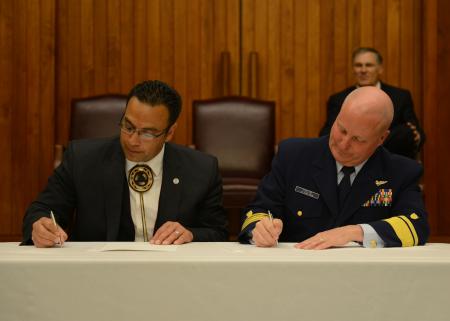Source: McClatchy Newspapers
WASHINGTON – Americans in coastal areas, particularly on the East and Gulf coasts, will confront challenging questions in the coming years as leaders determine how to protect millions of people in the face of rising sea levels and more intense storms.
Should cities rebuild the boardwalks in New Jersey shore towns? Should the government discourage people from rebuilding in areas now more vulnerable to flooding? How much would it cost to protect water and sewer systems, and subways and electrical substations from being inundated in the next storm?
Leaders from coastal communities along the East Coast gathered in New York City on Wednesday to talk about the consequences of Hurricane Sandy, as well as how they will address future sea level rising. The conference was sponsored by the Union of Concerned Scientists, a nonprofit, nonpartisan science advocacy group.
“What we really got a glimpse at was our collective future,” said Joe Vietri, who heads coastal and storm risk management for the U.S. Army Corps of Engineers and is heading up a comprehensive study of Sandy.
Rising sea levels caused primarily by global warming could worsen the effects of storms such as Sandy, particularly when it comes to storm surge. Since 1992, satellites have observed a 2.25-inch rise in global sea levels.
Just before Sandy, sea surface temperatures were about 5 degrees Fahrenheit above the 30-year average for the time of year. Scientists who studied the storm determined that about 1 degree was likely a direct result of global warming.
With every degree Fahrenheit rise in temperature, the atmosphere can hold 4 percent more moisture. As a result, Sandy was able to pull in more moisture, fueling a stronger storm and magnifying the amount of rainfall by as much as 5 percent to 10 percent compared with conditions more than 40 years ago.
Coupled with higher overall sea levels, the intense storm meant more water surging onshore and penetrating farther inland. The storm’s effects prompted officials in Wilmington, N.C., to look at its vulnerabilities if seas rise up to one meter by the end of the century.
“People are listening, people are ready to take some actions,” said Phil Prete, a senior environmental planner for the city.
The officials spent less time discussing the cause of rapid sea level rise: how to slow the carbon emissions that are heating up the Earth and warming the oceans. Many public officials in coastal communities instead are focusing on what they say are the consequences of global warming.
They have no choice, said Kristin Jacobs, mayor of Broward County, Fla., where extreme tides during Hurricane Sandy washed out portions of Fort Lauderdale’s iconic beachfront highway.
“Almost all of us are living in very low-lying areas,” she said. “There are many lessons in South Florida already learned from multiple hurricanes. We have learned from those hurricanes, we have learned to plan for the future, and we’ve learned that this is our new normal.”
The causes are also a settled question in Hoboken, N.J., where an estimated 500 million gallons of Hudson River water inundated the town and stayed for nearly 10 days, said Stephen Marks, Hoboken’s assistant business administrator. He called on the federal government and states to take a leadership role in addressing climate change, particularly in communities that are vulnerable to its effects.
“The debate about climate change is essentially over,” Marks said. “Hurricane Sandy settled that for, I would say, a majority of the residents in our city.”
But coastal populations are particularly vulnerable, and growing. The National Oceanic and Atmospheric Administration last month issued a report showing that already crowded U.S. coastal areas will see population grow from 123 million people in 2010 to nearly 134 million people by 2020. That puts millions more people at risk from storms such as Sandy.
People may be aware of the consequences of climate change, but it hasn’t seemed to have stopped anyone from moving to the beach – or hurt property values, said Vietri, of the Army Corps of Engineers. He noted that communities suffered far less damage if there were sand dunes or other protective measures, such as substantial setbacks for homes.
“You still have communities rebuilding almost exactly where they were prior to the storm coming,” Vietri said. “You continue to have a situation where we have a tremendous population density living in high-hazard areas.”














